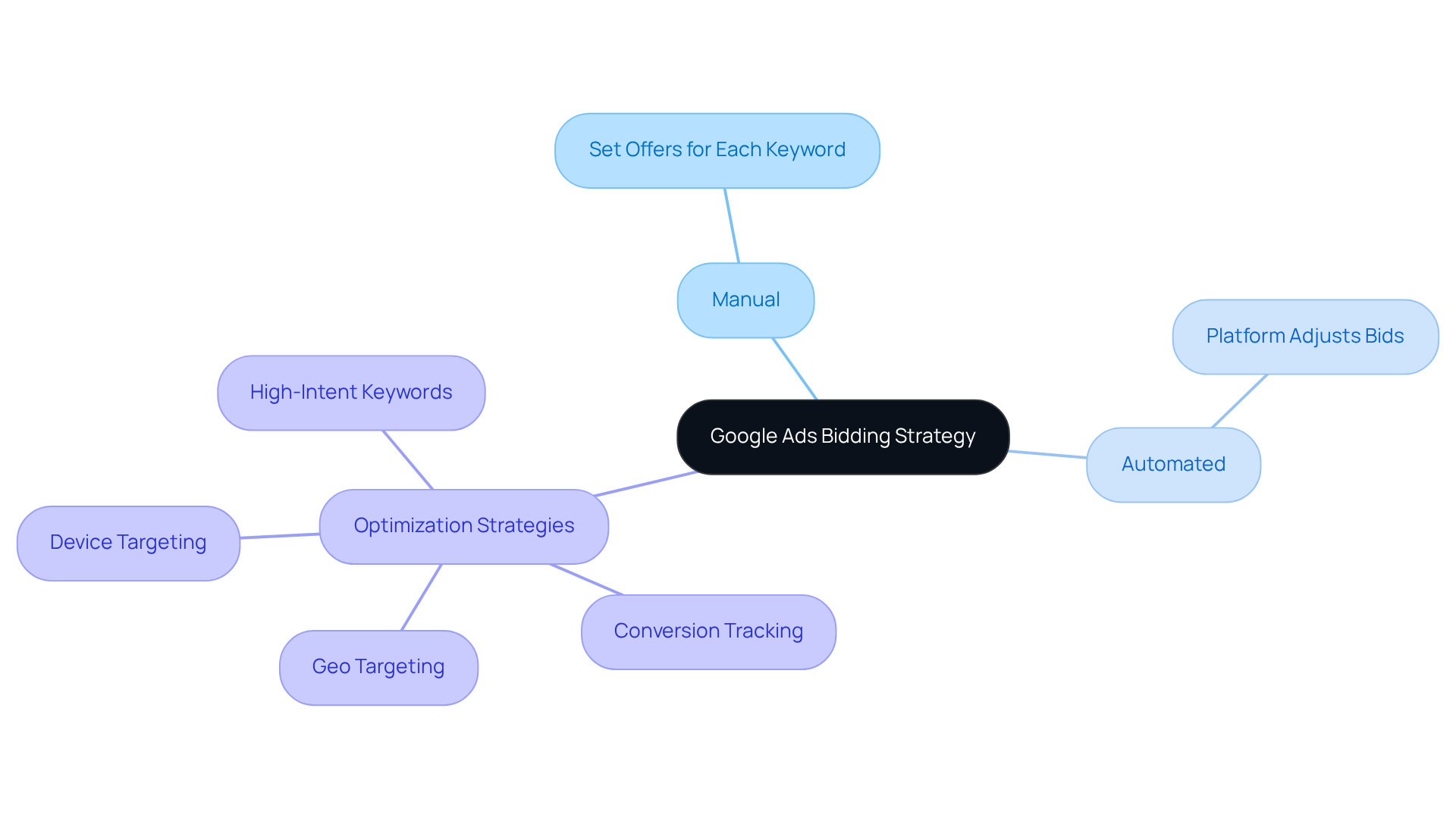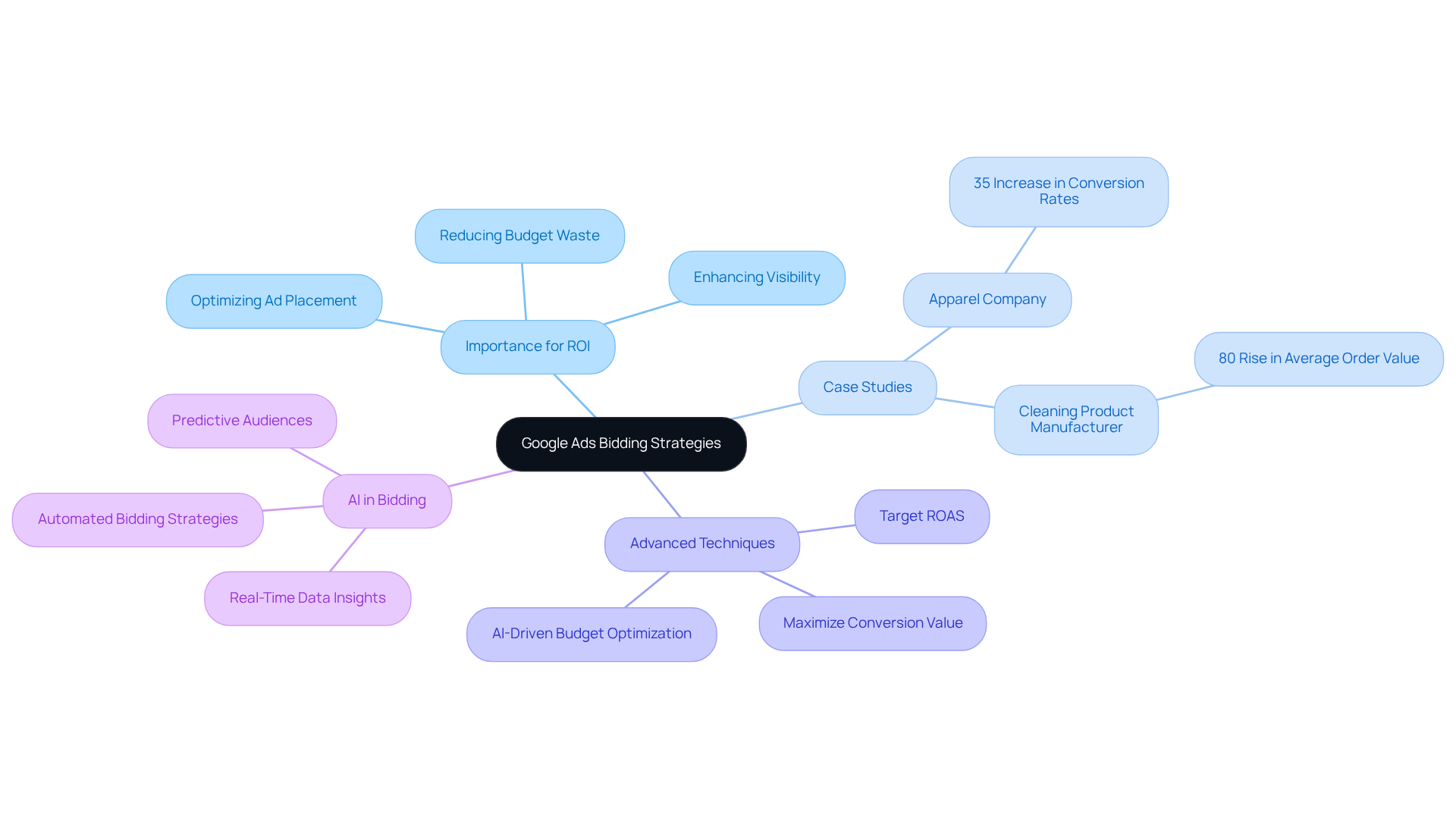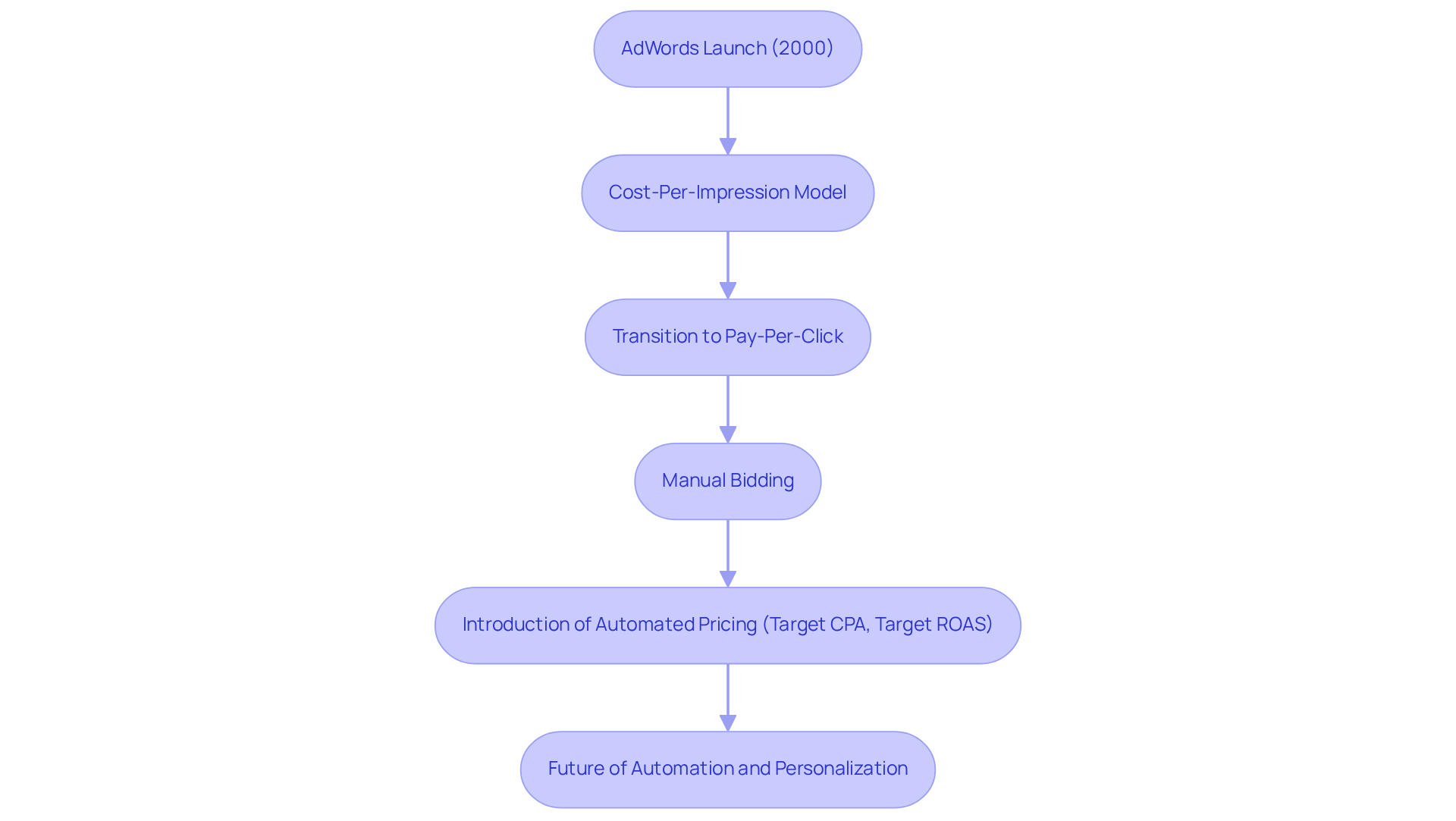
Overview
The article emphasizes the critical importance of Google Ads bidding strategies for direct-to-consumer (DTC) brands, underlining the necessity of optimizing advertising spend to enhance visibility and profitability. It presents various bidding approaches, including manual and automated strategies, while highlighting best practices such as:
- Data-driven decision-making
- Regular campaign adjustments
These practices are essential for improving ad performance and achieving marketing objectives in a competitive digital landscape.
Introduction
In the dynamic realm of digital marketing, the importance of a meticulously crafted Google Ads bidding strategy is paramount, particularly for direct-to-consumer (DTC) brands aiming for heightened visibility and profitability. As customer acquisition costs continue to escalate, grasping the intricacies of bidding strategies presents a vital edge for brands intent on optimizing their advertising expenditures. Yet, as competition intensifies, the pressing question arises: how can DTC companies adeptly maneuver through the complexities of Google Ads to ensure their campaigns not only reach but profoundly resonate with their target audience?
Define Google Ads Bidding Strategy
A google ads bidding strategy is a critical method that marketers use to determine the amount they are willing to pay for clicks on their advertisements. This google ads bidding strategy is essential for evaluating how effectively an advertisement can compete within the auction system employed by search engines to display ads. The google ads bidding strategy can be categorized into two types:
- Manual, where advertisers set their offers for each keyword.
- Automated, where the platform adjusts bids based on various performance-enhancing factors.
For direct-to-consumer (DTC) brands, mastering the google ads bidding strategy is vital for optimizing advertising spend and achieving better visibility in search results.
Implementing proper conversion tracking and selecting high-intent keywords are key steps for optimizing Google Ads, as these elements directly influence ad performance and return on ad spend (ROAS). Furthermore, employing geo and device targeting allows for more accurate pricing strategies, which can lead to reductions in cost-per-click (CPC) and enhanced ROAS. Effective google ads bidding strategies can significantly improve ad performance, ultimately leading to higher profitability for DTC companies. By adopting these approaches, brands can navigate the complexities of digital advertising with confidence and achieve their marketing objectives.

Contextualize the Role of Bidding Strategies in Digital Marketing
In the competitive landscape of digital marketing, particularly for direct-to-consumer (DTC) companies, a Google Ads bidding strategy is crucial for optimizing return on investment (ROI) from advertising campaigns. As customer acquisition costs are projected to rise significantly in 2025, an effective Google Ads bidding strategy can be the critical factor that distinguishes a successful campaign from a wasted budget. These strategies not only dictate ad placement but also enhance a company's visibility in search results, making them an indispensable element of any digital marketing strategy, especially in relation to a Google Ads bidding strategy.
Aligning pricing strategies with specific business objectives empowers companies to elevate their advertising efforts through a Google Ads bidding strategy, ensuring both efficiency and effectiveness. For instance, organizations that have embraced advanced auction techniques, such as Target ROAS and Maximize Conversion Value, have reported improved lead quality and reduced budget waste. Case studies from Parah Group illustrate this:
- A $30M apparel company experienced a 35% increase in conversion rates after optimizing their homepage and implementing strategic upsells.
- A cleaning product manufacturer saw an 80% rise in average order value by experimenting with free shipping thresholds and bundle offers.
Moreover, the anticipated cost of acquiring customers for DTC brands in 2025 will be significantly influenced by the sophistication of their Google Ads bidding strategy. Brands that utilize advanced algorithms and real-time data insights can achieve greater targeting accuracy, ultimately leading to enhanced conversion rates and improved ROI. Additionally, AI-driven budget optimization recommendations provide actionable insights based on real-time campaign performance, further refining the effectiveness of pricing strategies. As the digital advertising landscape continues to evolve, the implementation of a robust Google Ads bidding strategy is essential for navigating the complexities of modern marketing and achieving sustainable growth.

Trace the Evolution of Google Ads Bidding Strategies
The evolution of Ads auction techniques began with the launch of AdWords in 2000, which initially operated on a cost-per-impression model before transitioning to the pay-per-click (PPC) model. This pivotal shift transformed online advertising, enabling advertisers to pay solely when users clicked on their ads. Initially, advertisers were required to manually set bids for each keyword, which led to inefficiencies and missed opportunities. However, as the landscape evolved, Google introduced automated pricing strategies like Target CPA (Cost Per Acquisition) and Target ROAS (Return on Ad Spend), which are integral to the Google Ads bidding strategy that leverages machine learning to optimize bids in real-time based on performance data.
This progression mirrors a broader trend in digital marketing that favors data-driven decision-making, empowering DTC brands to utilize advanced algorithms to enhance their advertising effectiveness. Notably, data indicates that approximately 65% of small to medium-sized enterprises have adopted PPC campaigns, emphasizing the growing reliance on a Google Ads bidding strategy to succeed in a competitive marketplace. Furthermore, the average click-through rate (CTR) for online advertisements ranges from 4-6%, highlighting the effectiveness of these strategies.
The competitive landscape was further shaped by the legal dispute between Overture and another search engine, which underscored the importance of innovation in PPC advertising. Looking ahead, forthcoming advancements in Google Ads bidding strategy are expected to prioritize automation and personalization, further refining pricing strategies. As Brad Anderson, founder of Parah Group, aptly noted, "The platform has come a long way since its inception, continually adapting to meet the needs of advertisers.

Explore Different Types of Google Ads Bidding Strategies
The google ads bidding strategy offers a diverse array of approaches tailored to meet various advertising objectives, each presenting unique advantages for DTC brands. Key strategies include:
-
Manual CPC (Cost Per Click): This method empowers advertisers to set their own maximum bids for clicks, offering complete control over spending. However, it demands more effort and expertise, making it less attractive for some advertisers. By 2025, many advertisers continue to favor this approach for its transparency and direct oversight.
-
Enhanced CPC: An automated enhancement of manual CPC, this strategy adjusts bids in real-time based on conversion likelihood, effectively balancing control with automation. Remarkably, the average CPC has decreased by 34% while the cost per conversion remained stable, leading to a 19% increase in conversion volume. This aligns with a holistic approach to CRO, ensuring that paid ads are optimized for maximum profitability.
-
Target CPA (Cost Per Acquisition): This strategy focuses on maximizing conversions while keeping costs at or below a specified target. For example, brands like AnswerForce have successfully implemented Target CPA, achieving a 30% increase in conversions alongside a 12% reduction in CPA. Advertisers should aim to gather at least 15-30 conversions over a 30-day period to effectively evaluate their google ads bidding strategy, which reinforces the need for a data-driven approach to enhance results.
-
Target ROAS (Return on Ad Spend): This method emphasizes maximizing revenue by adjusting bids to meet a desired return on ad spend. Advertisers transitioning from Target CPA to Target ROAS can anticipate an approximate 14% increase in conversion value, making it an attractive option for companies pursuing profitability through strategic CRO practices.
-
Maximize Clicks: This automated strategy sets bids to generate the highest number of clicks within a specified budget, ideal for brands seeking to drive traffic quickly. Notably, Sticky Bunny experienced an astounding 1166% surge in sales after adopting this approach, attributed to a 270% growth in conversion rates, underscoring the transformative impact of effective CRO.
With 80% of advertisers now relying on automated bidding, grasping the nuances of these options is essential for optimizing ad spend and achieving desired outcomes. Furthermore, the learning phase for Smart Bidding approaches typically lasts 5-7 days, and regular evaluations of conversion tracking are vital for efficient campaign management. Each of these methods offers distinct advantages, enabling DTC companies to tailor their strategies, including their google ads bidding strategy, according to specific campaign goals and performance metrics. Additionally, aligning paid advertisements with landing pages is critical to ensure a cohesive approach that fosters sustainable growth.

Identify Key Characteristics and Best Practices for Effective Bidding
Effective Google Ads bidding strategies are underpinned by several key principles and best practices that can significantly enhance performance for DTC brands:
-
Data-Driven Decisions: Leveraging analytics is essential for informing bidding strategies. Decisions must be grounded in performance data rather than assumptions, ensuring that campaigns are optimized based on actual results. Parah Group emphasizes this approach, enabling advertisers to modify their plans effectively to market dynamics and enhance profitability.
-
Regular Monitoring and Adjustment: Continuous oversight of campaign performance is crucial. Regularly adjusting bids in response to market changes and competitive pressures helps maintain ad effectiveness and budget efficiency. This proactive approach is vital for maximizing ROI, especially considering the average cost per lead (CPL) in Google Ads for 2025 is $70.11.
-
Clear Objectives: Setting particular aims for each campaign—whether it’s enhancing traffic, generating leads, or increasing sales—directs the choice of suitable pricing approaches. Clear objectives ensure that every decision aligns with broader business aims, facilitating more effective campaign management.
-
Testing and Optimization: Conducting A/B testing is a best practice that enables companies to assess the effectiveness of different pricing strategies. By analyzing the results, DTC companies can optimize their approaches, leading to improved ad performance and higher conversion rates. Parah Group's CRO methodology underscores the significance of testing, as analyzing outcomes can lead to refined approaches and higher conversion rates.
-
Understanding Auction Strategies: Familiarize yourself with the two primary auction approaches in Ads: Manual strategies, which allow for greater control over individual offers, and Smart strategies, which automate offer adjustments based on performance data.
By following these best practices, DTC brands can enhance their offer techniques, ultimately leading to improved ad performance and a successful Google Ads bidding strategy that achieves higher conversion rates. The average conversion rate in Google Ads for 2025 stands at 7.52%, underscoring the potential for effective bidding strategies to yield significant results in a competitive landscape. Additionally, an ongoing CRO program, as highlighted by Parah Group, allows for data-driven decisions that contribute to business growth while reducing customer acquisition costs.

Conclusion
Understanding the intricacies of Google Ads bidding strategies is vital for direct-to-consumer (DTC) brands aiming to maximize their advertising effectiveness. By mastering these strategies, brands can navigate the competitive landscape of digital marketing, ensuring their ads achieve optimal visibility and engagement. The right bidding approach not only influences ad placement but also significantly impacts return on investment, making it a fundamental aspect of any successful marketing campaign.
Throughout the article, several key points have been emphasized:
- The distinction between manual and automated bidding strategies
- The importance of data-driven decision-making
- The necessity of regular monitoring and adjustments to optimize performance
By leveraging advanced techniques such as Target ROAS and Enhanced CPC, DTC brands can enhance their conversion rates while minimizing costs. Real-world case studies illustrate how strategic bidding can lead to substantial improvements in sales and customer acquisition.
In light of the anticipated increases in customer acquisition costs, the implementation of effective Google Ads bidding strategies is more crucial than ever. Brands are encouraged to embrace automation, utilize performance data, and continuously refine their approaches to stay ahead in the evolving digital landscape. By doing so, DTC companies can enhance their advertising outcomes and secure sustainable growth in a challenging market.
Frequently Asked Questions
What is a Google Ads bidding strategy?
A Google Ads bidding strategy is a method used by marketers to determine how much they are willing to pay for clicks on their advertisements, essential for competing in the auction system that search engines use to display ads.
What are the two main types of Google Ads bidding strategies?
The two main types of Google Ads bidding strategies are manual bidding, where advertisers set their offers for each keyword, and automated bidding, where the platform adjusts bids based on various performance-enhancing factors.
Why is mastering Google Ads bidding strategy important for direct-to-consumer (DTC) brands?
Mastering Google Ads bidding strategy is vital for DTC brands to optimize advertising spend and achieve better visibility in search results, which can lead to improved ad performance and profitability.
What are key steps for optimizing Google Ads?
Key steps for optimizing Google Ads include implementing proper conversion tracking, selecting high-intent keywords, and employing geo and device targeting to enhance pricing strategies.
How can effective Google Ads bidding strategies impact profitability for DTC companies?
Effective Google Ads bidding strategies can significantly improve ad performance, leading to higher profitability by reducing cost-per-click (CPC) and enhancing return on ad spend (ROAS).
What role do Google Ads bidding strategies play in digital marketing?
Google Ads bidding strategies are crucial for optimizing return on investment (ROI) from advertising campaigns, especially for DTC companies, as they dictate ad placement and enhance visibility in search results.
How can advanced auction techniques improve advertising outcomes?
Advanced auction techniques, such as Target ROAS and Maximize Conversion Value, can improve lead quality and reduce budget waste, leading to better advertising outcomes.
What are some examples of companies that improved their performance through Google Ads bidding strategies?
For example, a $30M apparel company experienced a 35% increase in conversion rates after optimizing their homepage, while a cleaning product manufacturer saw an 80% rise in average order value by experimenting with free shipping thresholds and bundle offers.
How will customer acquisition costs in 2025 be influenced by Google Ads bidding strategies?
The anticipated rise in customer acquisition costs for DTC brands in 2025 will be significantly influenced by the sophistication of their Google Ads bidding strategies, with advanced algorithms and real-time data insights leading to greater targeting accuracy and improved ROI.
What additional tools can enhance the effectiveness of Google Ads bidding strategies?
AI-driven budget optimization recommendations can provide actionable insights based on real-time campaign performance, further refining the effectiveness of pricing strategies in digital advertising.
FAQs











